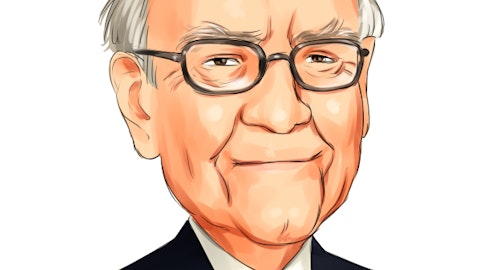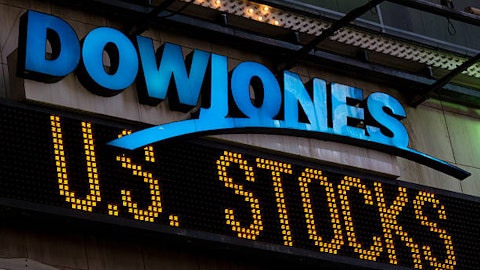Christophe Le Caillec: Yes. So T&E, sequentially the growth rate came down. I need to point out though that is still up 9% year-over-year, so it’s a pretty strong growth rate. In terms of airline spend, and if you heard, I’m sure the various airline, they all made comments about the bid of a softer demand. And since many of those customers are using an American Express card to pay for the airline ticket, we saw a similar trend. This being said, booking remains very strong on our TLS segment. I don’t have the numbers in front of me, but I know there were strong. So I don’t — we’ll see whether it’s the beginning of a trend or whether it’s a data point. But we keep you know seeing a lot of strength and you know the partnership we have with Delta is working very, very well.
Originations of new cards are very strong. And here card members decided to redeem a bit less in Q4 with airline tickets than they did in the past and we’ve seen in the — that choppiness as well in the past. I don’t worry. It’s one data point. And for 2024, we haven’t either communicated on exactly what assumptions we’re making by category, but either, I’m not too worried. We have a card member base that loves traveling, and I’m sure they’re going to keep traveling.
Operator: Thank you. The next question is coming from Rick Shane of JPMorgan. Please go ahead.
Rick Shane: Thanks for taking my questions this morning. Look, you guys have alluded to the fact that the reserve rate is going to go up or drift up in 2024. I’m curious if what’s driving that. Presumably, it’s a mix-shift between loans and card member receivables, but I’m wondering if, at any level, you’re also suggesting that the reserve rate on the loan portfolio is going to go up as a reflection of either — some sort of shift there. Is it just a pure mix-shift as the loan portfolio grows faster than the card member receivables?
Christophe Le Caillec: Yes. So thank you, Rick, for your question. This is very — this is an important point, so I’m glad you’re asking the question. The first thing I want to say is that, the absolute levels when you look at the delinquency rates or the write-off rates are very low in terms of our historical performance, and on the slide I put as well the pre-pandemic levels. The write-off rate is 2% in Q4. It was 2.2% pre-pandemic, right? So we’re still below where we were pre-pandemic. So in absolute they’re very low. Relative to our peers, , which I know you know well, they also very good. And I’m sure you noted that every competitor or peer reported their numbers and experienced the same tick, but at a higher magnitude.
I would take up of 20 basis point is one of the lowest in the industry. So I feel good about where we are and I feel good about the trend. When it comes to the dynamic in the portfolio, the key driver behind this is that there’s still some normalization going on here. We are moving from sub-1% write-off rate during the pandemic. As you all know on this call, this was not a sustainable level and these rates are normalizing and they are normalizing at a slow pace, and I like that, and the 2% is, again, a place where I feel comfortable from a credit standpoint. The other thing to expand a little bit and take a step back in terms of, you know, what kind of loan growth we are seeing. The biggest contributors in terms of loan balances are their pay overtime facility that we offered with our charged products and their co-brands cards.
And so both those portfolio have very strong credit profile and better credit profile than what we call internally proprietary lending, which includes blue cash every day for instance. So if anything, the profile of the portfolio and the mix of the portfolio is shifting and evolving more towards product that have a strong credit profile and high velocity. This being said, that normalization is happening and that’s what’s creating that little tick-up. And as I said in my comments, we’re not quite done with that normalization, there’s still a bit more to come in our minds, but not a lot.
Operator: Thank you. The next question is coming from Saul Martinez of HSBC. Please go ahead.
Saul Martinez: Hey, good morning. Thanks for taking my question. Just ask on capital, is there any updated thoughts on how you’re thinking about Basel end game? Obviously, your preliminary expectations of the proposal, at least, are that it would take you down to closer to 7%, but there is a lot of talk about that being softened, just how are you thinking about capital management, you obviously increase your dividend, but how are you thinking about buybacks going forward in light of the uncertainty?
Christophe Le Caillec: Yes, so thank you for your question. So not a lot has changed on that front outside of the fact that we’ve been meeting with regulators, Steve met with regulators, I met with regulators as well. And what I can tell you is that they’re listening, they’re engaged, and I think they understand our comments. The ball is back in their camp now and they’re incorporating all the comments they receive from the industry and I’m sure you’ve seen a lot of those comments as well. So they have a lot of work to do. Right now we’re in waiting mode. And I think we’re expecting the current estimate is we’re expecting their — or at least their next version of the rules by the end of 2024, we’ll see. It took 10-years to get to their first draft, so we’ll see when we get the next version.





